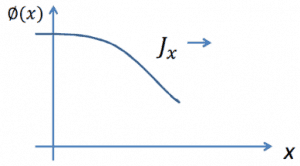In chemistry, Fick’s law states that:
Suppose the concentration of a solute in one region is greater than in another of a solution. In that case, the solute diffuses from the region of higher concentration to the region of lower concentration, with a magnitude that is proportional to the concentration gradient.
In one (spatial) dimension, the law is:
where:
- J is the diffusion flux,
- D is the diffusion coefficient,
- φ (for ideal mixtures) is the concentration.
The use of this law in nuclear reactor theory leads to the diffusion approximation.
Fick’s law in reactor theory states that:
The current density vector J is proportional to the negative of the gradient of the neutron flux. The proportionality constant is called the diffusion coefficient and is denoted by the symbol D.
In one (spatial) dimension, the law is:
where:
- J is the neutron current density (neutrons.cm-2.s-1) along the x-direction, the net flow of neutrons that pass per unit of time through a unit area perpendicular to the x-direction.
- D is the diffusion coefficient, it has the unit of cm, and it is given by:

- φ is the neutron flux, the number of neutrons crossing through some arbitrary cross-sectional unit area in all directions per unit time.
The generalized Fick’s law (in three dimension) is:
![]()
where J denotes the diffusion flux vector. Note that the gradient operator turns the neutron flux, which is a scalar quantity into the neutron current, which is a vector quantity.
Physical Interpretation
 The physical interpretation is similar to the fluxes of gases. The neutrons exhibit a net flow in the direction of least density. This is a natural consequence of greater collision densities at positions of greater neutron densities.
The physical interpretation is similar to the fluxes of gases. The neutrons exhibit a net flow in the direction of least density. This is a natural consequence of greater collision densities at positions of greater neutron densities.
Consider neutrons passing through the plane at x=0 from left to right due to collisions to the left of the plane. Since the concentration of neutrons and the flux is larger for negative values of x, there are more collisions per cubic centimeter on the left. Therefore more neutrons are scattered from left to right, then the other way around. Thus the neutrons naturally diffuse toward the right.
Validity of Fick’s Law
It must be emphasized that Fick’s law is an approximation and was derived under the following conditions:
- Infinite medium. This assumption is necessary to allow integration of overall space. Still, flux contributions are negligible beyond a few mean free paths (about three mean free paths) from the boundaries of the diffusive medium.
- Sources or sinks. Derivation of Fick’s law assumes that the contribution to the flux is mostly from elastic scattering reactions. Source neutrons contribute to the flux if they are more than a few mean free paths from a source.
- Uniform medium. Derivation of Fick’s law assumes that a uniform medium was used. There are different scattering properties at the boundary (interface) between the two media.
- Isotropic scattering. Isotropic scattering occurs at low energies but is not true in general. Anisotropic scattering can be corrected by modification of the diffusion coefficient (based on transport theory).
- Low absorbing medium. Fick’s law derivation assumes (an expansion in Taylor’s series) that the neutron flux, φ, is slowly varying. Large variations in φ occur when Σa (neutron absorption) is large (compared to Σs). Σa << Σs
- Time-independent flux. Derivation of Fick’s law assumes that the neutron flux is independent of time.
To some extent, these limitations are valid in every practical reactor. Nevertheless Fick’s law gives a reasonable approximation. For more detailed calculations, higher order methods are available.




